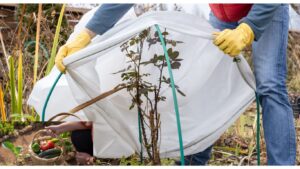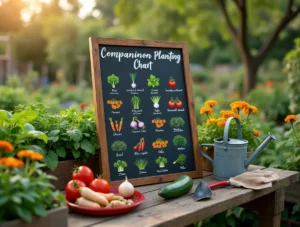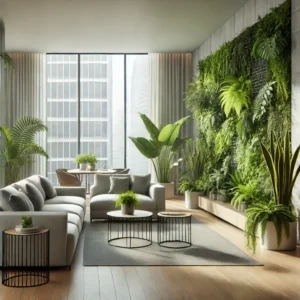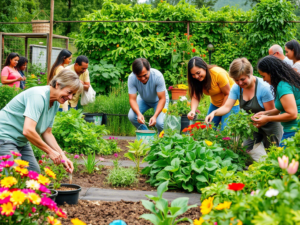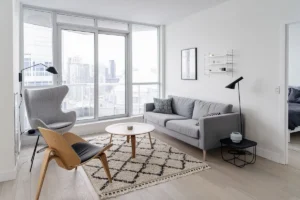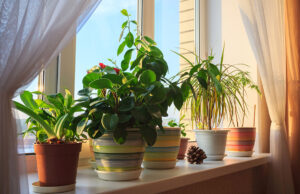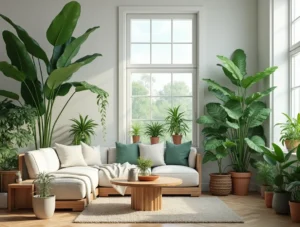Introduction
Indoor gardening has surged in popularity, transforming living spaces into lush, green retreats. Not only do indoor gardens enhance the aesthetic appeal of your home, but they also offer numerous benefits, such as improved air quality and mental well-being. In this comprehensive guide, we’ll explore seven innovative indoor garden ideas to elevate your home. Whether you’re a seasoned gardener or a beginner, these ideas will inspire you to bring a bit of the outdoors inside.
On This Page
1. Vertical Gardens
What is a Vertical Garden?
A vertical garden, also known as a living wall, is a method of growing plants on a vertically suspended panel using hydroponics. These unique gardens can be attached to both interior and exterior walls and are a fantastic solution for small spaces.
Benefits of Vertical Gardens
- Space-saving Solution: Vertical gardens utilize vertical space, making them ideal for apartments and small homes.
- Aesthetic Appeal: They add a lush, green look to any wall, creating a striking visual impact.
- Air Purification: Plants in vertical gardens can help filter pollutants and improve indoor air quality.
How to Create a Vertical Garden
To create a vertical garden, you’ll need a few basic materials:
- Planters or planting panels
- A trellis or frame
- Hooks or brackets for mounting
- Soil and plants
Step-by-Step Guide:
- Choose a Location: Select a wall that receives adequate natural light.
- Install the Frame: Mount the trellis or frame securely to the wall.
- Prepare the Planters: Fill the planters with soil and arrange them on the frame.
- Plant Selection: Choose plants suitable for vertical growth.
- Watering System: Consider installing a drip irrigation system for easy maintenance.
Best Plants for Vertical Gardens
Here are some excellent plant choices for vertical gardens:
- Ferns: These thrive in shaded areas and add a lush look.
- Pothos: Known for their trailing vines and low maintenance.
- Succulents: Perfect for low-water environments and come in various shapes and colors.
For more plant ideas, check out These 14 Plants Will Make Any Room Look Better.
2. Terrariums

What is a Terrarium?
A terrarium is a miniature garden enclosed in a glass container, creating a small ecosystem. Terrariums can be either closed (with a lid) or open (without a lid), each offering a unique aesthetic and environmental condition.
Benefits of Terrariums
- Low Maintenance: Terrariums are self-sustaining ecosystems that require minimal care.
- Compact and Decorative: They are perfect for small spaces and add a unique, decorative element to your home.
- Educational: Terrariums offer a great way to learn about ecosystems and plant care.
How to Create a Terrarium
To create a terrarium, gather the following materials:
- A clear glass container (e.g., a fishbowl, mason jar, or specialized terrarium container)
- Pebbles or small stones
- Activated charcoal (for closed terrariums)
- Potting soil
- Small plants
- Decorative elements (optional, e.g., figurines, moss)
Step-by-Step Guide:
- Prepare the Container: Clean the glass container thoroughly.
- Add Pebbles: Place a layer of pebbles at the bottom for drainage.
- Add Activated Charcoal: For closed terrariums, add a thin layer of activated charcoal to prevent mold and odors.
- Add Soil: Add a layer of potting soil suitable for the chosen plants.
- Plant Selection: Choose small plants that thrive in the same conditions.
- Planting: Arrange the plants in the soil, ensuring they have enough space to grow.
- Decorate: Add moss, stones, or figurines to enhance the aesthetic.
Best Plants for Terrariums
Here are some ideal plants for terrariums:
- Air Plants (Tillandsia): Require no soil and are easy to care for.
- Mini Succulents: Perfect for open terrariums, these need minimal water.
- Moss: Adds a lush, green carpet to your terrarium and thrives in high humidity.
For more detailed guidance, check out this helpful guide on creating Terrariums.
3. Indoor Herb Gardens
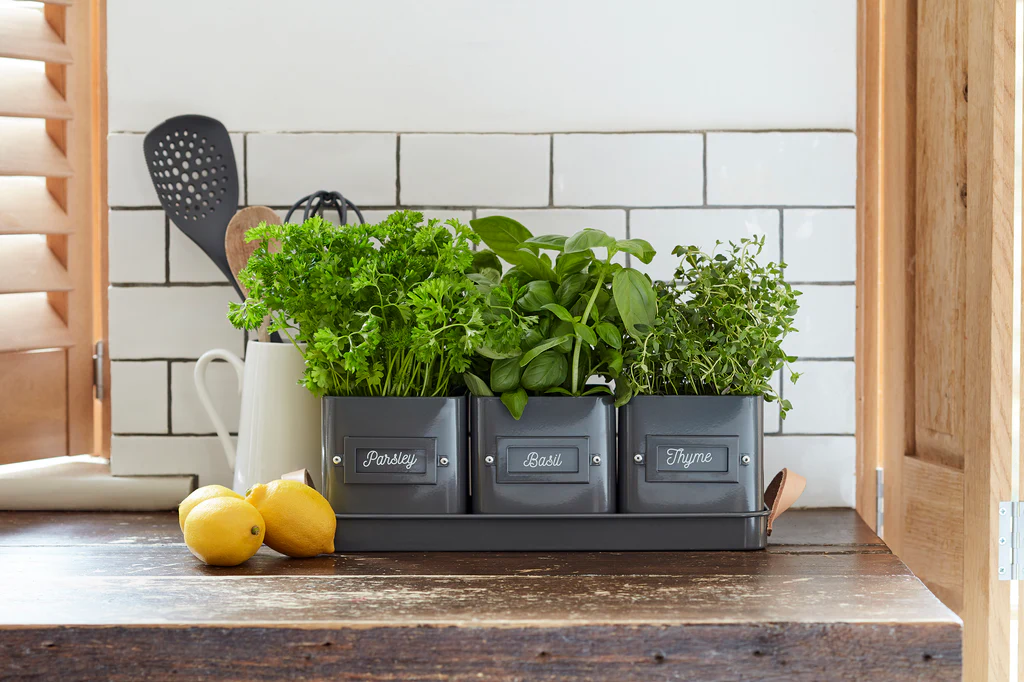
Benefits of an Indoor Herb Garden
An indoor herb garden not only adds greenery to your home but also provides fresh herbs for cooking. The aromatic plants can also enhance the ambiance of your kitchen or living space.
- Fresh Herbs for Cooking: Always have fresh, flavorful herbs at your fingertips.
- Pleasant Fragrance: Herbs like basil and mint can freshen up your home with their delightful scents.
How to Start an Indoor Herb Garden
To start your indoor herb garden, you’ll need:
- Pots or containers with drainage holes
- Potting soil
- Herb seeds or seedlings
Step-by-Step Guide:
- Choose a Location: Find a sunny spot that receives at least 6 hours of sunlight daily.
- Prepare the Pots: Fill the pots with potting soil.
- Planting: Sow the seeds or plant the seedlings according to the instructions.
- Watering: Water the herbs regularly, ensuring the soil is moist but not waterlogged.
- Maintenance: Trim and harvest herbs regularly to promote growth.
Best Herbs for Indoor Gardens
Consider these easy-to-grow herbs for your indoor garden:
- Basil: A versatile herb that thrives in sunny spots.
- Mint: Grows well indoors and adds a refreshing aroma.
- Rosemary: A hardy herb that prefers well-drained soil.
For more inspiration on combining herbs and flowers, check out 11 Ideas for Combining Flowers in Garden.
4. Hanging Gardens
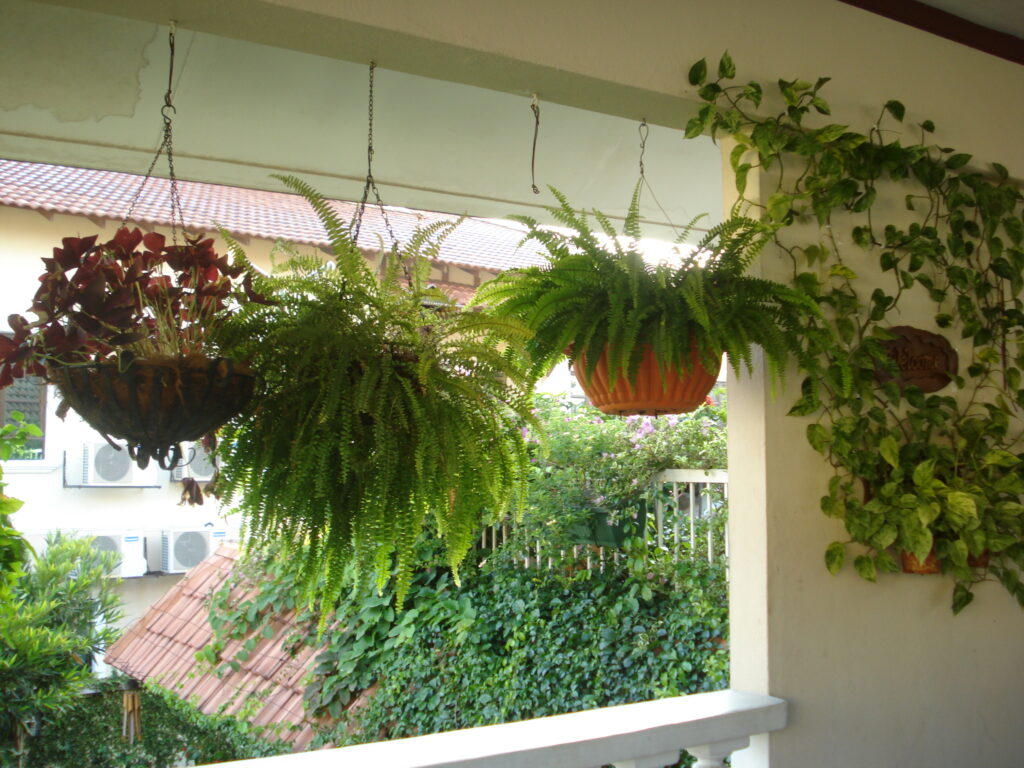
What is a Hanging Garden?
A hanging garden involves growing plants in containers that are suspended from the ceiling or mounted on walls. This creative approach to gardening not only saves space but also adds a dynamic and eye-catching element to your home decor.
Benefits of Hanging Gardens
- Space-saving: Ideal for small apartments and homes where floor space is limited.
- Decorative Appeal: Adds a unique and stylish touch to any room.
- Improved Air Quality: Helps in purifying the air by absorbing toxins.
How to Create a Hanging Garden
Creating a hanging garden requires a few basic materials:
- Hanging planters or baskets
- Hooks, chains, or macramé hangers
- Potting soil
- Plants
Step-by-Step Guide:
- Choose a Location: Find a spot that receives adequate light and has enough space for the hanging planters.
- Install Hooks or Chains: Securely install hooks or chains in the ceiling or wall to support the weight of the planters.
- Prepare the Planters: Fill the hanging planters with potting soil.
- Plant Selection: Choose plants that thrive in hanging conditions.
- Planting: Place the plants in the soil and secure them properly.
- Watering: Water the plants regularly and ensure proper drainage.
Best Plants for Hanging Gardens
Here are some ideal plants for hanging gardens:
- Spider Plants: Known for their long, arching leaves and easy maintenance.
- Trailing Ivy: Adds a cascading effect with its trailing vines.
- Philodendrons: Perfect for indoor hanging gardens with their heart-shaped leaves.
For more plant ideas, check out These 14 Plants Will Make Any Room Look Better.
5. Indoor Hydroponic Gardens
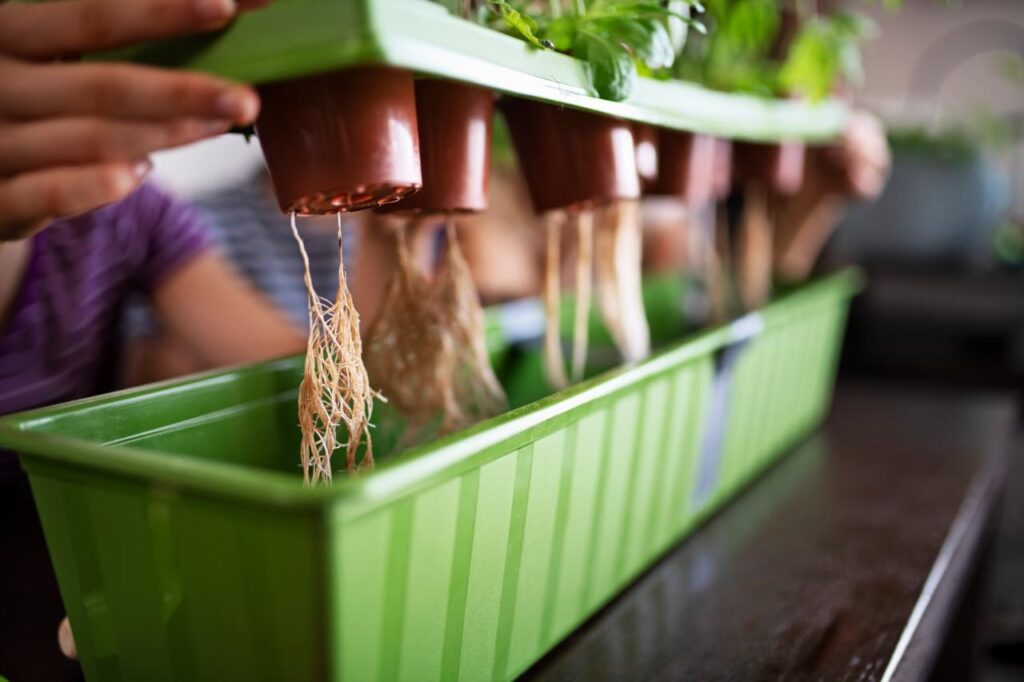
What is Hydroponics?
Hydroponics is a method of growing plants without soil, using nutrient-rich water instead. This technique allows for efficient use of space and resources, making it ideal for indoor gardening.
Benefits of Indoor Hydroponic Gardens
- Soil-free Gardening: Eliminates the mess and challenges associated with soil-based gardening.
- Faster Plant Growth: Plants often grow faster in hydroponic systems due to direct access to nutrients.
- Space-efficient: Ideal for small spaces as plants can be grown vertically or in compact setups.
How to Set Up an Indoor Hydroponic Garden
Setting up a hydroponic garden requires the following materials:
- Hydroponic system (e.g., nutrient film technique, deep water culture)
- Nutrient solution
- Grow lights (if natural light is insufficient)
- Plants or seeds
Step-by-Step Guide:
- Choose a Hydroponic System: Select a system that fits your space and needs.
- Set Up the System: Assemble the hydroponic system according to the manufacturer’s instructions.
- Prepare the Nutrient Solution: Mix the nutrient solution as per the guidelines.
- Plant Selection: Choose plants that are well-suited for hydroponic growth.
- Planting: Place the plants or seeds in the system.
- Lighting: Ensure the plants receive adequate light, either naturally or through grow lights.
- Maintenance: Regularly check the nutrient solution and adjust as needed.
Best Plants for Indoor Hydroponic Gardens
Consider these plants for your hydroponic garden:
- Lettuce: Grows quickly and is ideal for salads.
- Tomatoes: Thrives in hydroponic systems and produces abundant fruit.
- Herbs: Basil, mint, and parsley are excellent choices for hydroponic gardens.
For more information on hydroponics, visit Hydroponic Systems Explained.
6. Windowsill Gardens
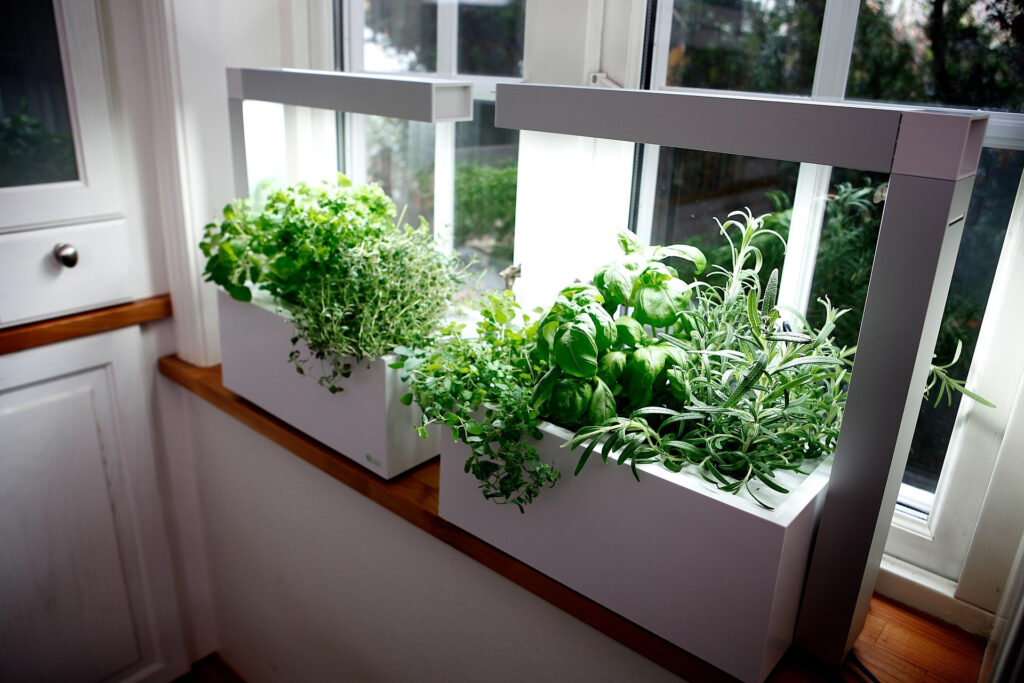
Benefits of Windowsill Gardens
Windowsill gardens are an excellent way to utilize natural light and create a mini garden right by your window. They are perfect for those with limited space and provide easy access to your plants.
- Utilization of Natural Light: Plants receive direct sunlight, promoting healthy growth.
- Easy Access and Maintenance: Convenient location for watering and care.
How to Create a Windowsill Garden
To start a windowsill garden, you’ll need:
- Containers or pots with drainage holes
- Potting soil
- Plants or seeds
Step-by-Step Guide:
- Choose a Location: Select a sunny windowsill that receives ample light.
- Prepare the Containers: Fill the pots with potting soil.
- Plant Selection: Choose plants that thrive in the light conditions available.
- Planting: Sow the seeds or plant the seedlings in the soil.
- Watering: Water the plants regularly, ensuring the soil stays moist but not waterlogged.
- Maintenance: Rotate the plants periodically to ensure even growth.
Best Plants for Windowsill Gardens
Here are some plants that thrive on windowsills:
- Cacti: Require minimal water and thrive in bright sunlight.
- Succulents: Perfect for windowsills, they need little water and lots of light.
- Small Herbs: Basil, chives, and thyme are great choices for a kitchen windowsill garden.
For more inspiration, visit 11 Ideas for Combining Flowers in Garden.
7. Indoor Fairy Gardens

What is a fairy garden?
A fairy garden is a miniature garden that includes small plants, decorative elements, and tiny figurines to create a whimsical and magical scene. These gardens are often housed in containers and can be placed indoors.
Benefits of Indoor Fairy Gardens
- Creative and Whimsical Decor: Adds a touch of magic and creativity to your home.
- Fun Project: Ideal for both children and adults, offering a fun and engaging activity.
- Compact and Versatile: Can be created in various containers and fit into small spaces.
How to Create an Indoor Fairy Garden
To create a fairy garden, gather the following materials:
- A shallow container or tray
- Potting soil
- Small plants
- Miniature furniture and figurines
- Decorative elements (e.g., stones, moss, fairy lights)
Step-by-Step Guide:
- Choose a Container: Select a shallow container that suits your space and style.
- Add Soil: Fill the container with potting soil.
- Plant Selection: Choose small plants that fit well in the container.
- Planting: Arrange the plants in the soil, leaving space for decorative elements.
- Decorate: Add miniature furniture, figurines, and other decorative items to create a whimsical scene.
- Maintenance: Water the plants as needed and occasionally rearrange the decor to keep it fresh.
Best Plants for Fairy Gardens
Consider these plants for your fairy garden:
- Baby Tears (Soleirolia): Forms a lush, green carpet that adds a magical touch.
- Mini Ferns: Small and delicate, perfect for fairy gardens.
- Moss: Adds a natural, earthy feel and thrives in humid conditions.
General Tips for Indoor Gardening
Choosing the Right Plants
When selecting plants for your indoor garden, consider the following factors:
- Light Requirements: Ensure the plants you choose can thrive in the available light conditions.
- Humidity: Some plants prefer higher humidity levels, which can be achieved with regular misting or using a humidifier.
- Space: Choose plants that fit the available space and do not overcrowd each other.
Care and Maintenance
Proper care and maintenance are crucial for a thriving indoor garden:
- Watering: Understand the specific watering needs of each plant. Overwatering or underwatering can harm your plants.
- Pest Control: Regularly check for pests and treat them promptly with natural or chemical solutions.
- Fertilization: Use appropriate fertilizers to provide necessary nutrients for plant growth.
Enhancing Indoor Garden Aesthetics
- Decorative Planters: Use stylish and colorful planters to enhance the visual appeal of your indoor garden.
- Integration with Home Decor: Match the garden elements with your home’s interior design to create a cohesive look.
Conclusion
Creating an indoor garden is a wonderful way to bring nature into your home, improve air quality, and enhance your living space’s aesthetic appeal. By exploring these seven indoor garden ideas, you can find the perfect fit for your style and space. Start small, experiment with different plants and arrangements, and enjoy the process of transforming your home into a green oasis.
Remember to share your indoor garden ideas and experiences, and don’t hesitate to explore additional resources like These 14 Plants Will Make Any Room Look Better and 11 Ideas for Combining Flowers in Garden.


